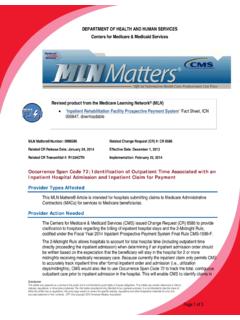Transcription of Centers for Medicare & Medicaid Services, HHS 411
1 343 Centers for Medicare & Medicaid services , HHS provided by the referring physician. A designated health service is not person-ally performed or provided by the re-ferring physician if it is performed or provided by any other person, includ-ing, but not limited to, the referring physician s employees, independent contractors, or group practice mem-bers. (ii) Except as provided in paragraph (2) of this definition, a request by a physician that includes the provision of any designated health service for which payment may be made under Medicare , the establishment of a plan of care by a physician that includes the provision of such a designated health service, or the certifying or recerti-fying of the need for such a designated health service, but not including any designated health service personally performed or provided by the referring physician.
2 A designated health service is not personally performed or provided by the referring physician if it is per-formed or provided by any other person including, but not limited to, the refer-ring physician s employees, inde-pendent contractors, or group practice members. (2) Does not include a request by a pathologist for clinical diagnostic lab-oratory tests and pathological exam-ination services , by a radiologist for di-agnostic radiology services , and by a radiation oncologist for radiation ther-apy, if (i) The request results from a con-sultation initiated by another physi-cian (whether the request for a con-sultation was made to a particular physician or to an entity with which the physician is affiliated); and (ii) The tests or services are fur-nished by or under the supervision of the pathologist, radiologist, or radi-ation oncologist.
3 (3) Can be in any form, including, but not limited to, written, oral, or elec-tronic. Referring physician means a physician who makes a referral as defined in this section or who directs another person or entity to make a referral or who controls referrals made by another per-son or entity. Remuneration means any payment or other benefit made directly or indi-rectly, overtly or covertly, in cash or in kind, except that the following are not considered remuneration for pur-poses of this section: (1) The forgiveness of amounts owed for inaccurate tests or procedures, mis-takenly performed tests or procedures, or the correction of minor billing er-rors.
4 (2) The furnishing of items, devices, or supplies (not including surgical items, devices, or supplies) that are used solely to collect, transport, proc-ess, or store specimens for the entity furnishing the items, devices, or sup-plies or are used solely to order or com-municate the results of tests or proce-dures for the entity. (3) A payment made by an insurer or a self-insured plan to a physician to satisfy a claim, submitted on a fee-for-service basis, for the furnishing of health services by that physician to an individual who is covered by a policy with the insurer or by the self-insured plan, if (i) The health services are not fur-nished, and the payment is not made, under a contract or other arrangement between the insurer or the plan and the physician; (ii) The payment is made to the phy-sician on behalf of the covered indi-vidual and would otherwise be made di-rectly to the individual.
5 And (iii) The amount of the payment is set in advance, does not exceed fair market value, and is not determined in a manner that takes into account di-rectly or indirectly the volume or value of any referrals. Same building means a structure with, or combination of structures that share, a single street address as as-signed by the Postal Service, ex-cluding all exterior spaces (for exam-ple, lawns, courtyards, driveways, parking lots) and interior parking ga-rages. For purposes of this rule, the same building does not include a mo-bile vehicle, van, or trailer. [66 FR 952, Jan.]
6 4, 2001] Group practice. For purposes of this subpart, a group practice is a physician practice that meets the following conditions: (a) Single legal entity. The group prac-tice must consist of a single legal enti-ty formed primarily for the purpose of VerDate 0ct<09>2002 01:11 Oct 24, 2002 Jkt 197170 PO 00000 Frm 00343 Fmt 8010 Sfmt 8010 Y:\SGML\ 197170T34442 CFR Ch. IV (10 1 02 Edition) being a physician group practice in any organizational form recognized by the State in which the group practice achieves its legal status, including, but not limited to, a partnership, profes-sional corporation, limited liability company, foundation, not-for-profit corporation, faculty practice plan, or similar association.
7 The single legal entity may be organized by any party or parties, including, but not limited to, physicians, health care facilities, or other persons or entities (including, but not limited to, physicians individ-ually incorporated as professional cor-porations). The single legal entity may not be organized or owned (in whole or in part) by another medical practice that is an operating physician practice (regardless of whether the medical practice meets the conditions for a group practice under this section). For purposes of this rule, a single legal en-tity does not include informal affili-ations of physicians formed substan-tially to share profits from referrals, or separate group practices under com-mon ownership or control through a physician practice management com-pany, hospital, health system, or other entity or organization.
8 A group prac-tice that is otherwise a single legal en-tity may itself own subsidiary entities. (b) Physicians. The group practice must have at least two physicians who are members of the group (whether em-ployees or direct or indirect owners), as defined in this section. (c) Range of care. Each physician who is a member of the group, as defined in , must furnish substantially the full range of patient care services that the physician routinely furnishes, in-cluding medical care, consultation, di-agnosis, and treatment, through the joint use of shared office space, facili-ties, equipment, and personnel. (d) services furnished by group practice members.
9 (1) Except as provided in para-graphs (d)(2) and (d)(3) of this section, substantially all of the patient care services of the physicians who are mem-bers of the group (that is, at least 75 per-cent of the total patient care services of the group practice members) must be furnished through the group and billed under a billing number assigned to the group, and the amounts received must be treated as receipts of the group. Patient care services must be measured by one of the following: (i) The total time each member spends on patient care services docu-mented by any reasonable means (in-cluding, but not limited to, time cards, appointment schedules, or personal diaries).
10 (For example, if a physician practices 40 hours a week and spends 30 hours on patient care services for a group practice, the physician has spent 75 percent of his or her time providing patient care services for the group.) (ii) Any alternative measure that is reasonable, fixed in advance of the per-formance of the services being meas-ured, uniformly applied over time, verifiable, and documented. (2) The data used to calculate compli-ance with this substantially all test and related supportive documentation must be made available to the Sec-retary upon request. (3) The substantially all test does not apply to any group practice that is located solely in an HPSA, as defined in (4) For a group practice located out-side of an HPSA (as defined in ), any time spent by a group practice member providing services in an HPSA should not be used to calculate wheth-er the group practice has met the substantially all test, regardless of whether the member s time in the HPSA is spent in a group practice, clin-ic, or office setting.





